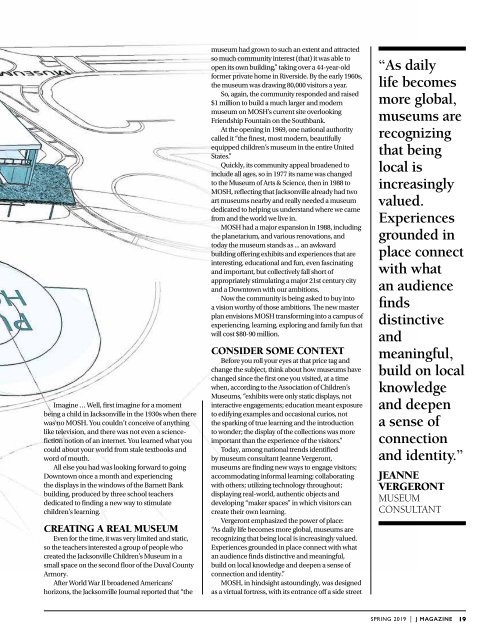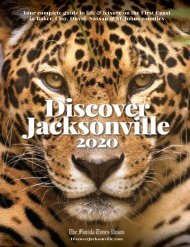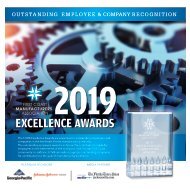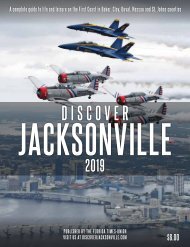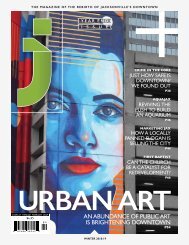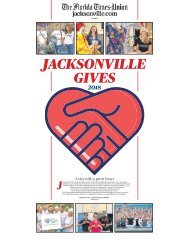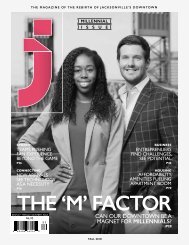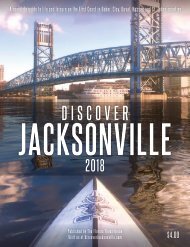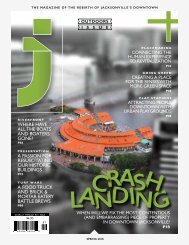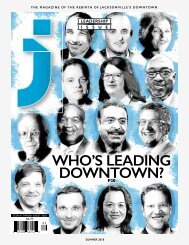J Magazine Spring 2019
You also want an ePaper? Increase the reach of your titles
YUMPU automatically turns print PDFs into web optimized ePapers that Google loves.
Imagine … Well, first imagine for a moment<br />
being a child in Jacksonville in the 1930s when there<br />
was no MOSH. You couldn’t conceive of anything<br />
like television, and there was not even a sciencefiction<br />
notion of an internet. You learned what you<br />
could about your world from stale textbooks and<br />
word of mouth.<br />
All else you had was looking forward to going<br />
Downtown once a month and experiencing<br />
the displays in the windows of the Barnett Bank<br />
building, produced by three school teachers<br />
dedicated to finding a new way to stimulate<br />
children’s learning.<br />
Creating a real museum<br />
Even for the time, it was very limited and static,<br />
so the teachers interested a group of people who<br />
created the Jacksonville Children’s Museum in a<br />
small space on the second floor of the Duval County<br />
Armory.<br />
After World War II broadened Americans’<br />
horizons, the Jacksonville Journal reported that “the<br />
museum had grown to such an extent and attracted<br />
so much community interest (that) it was able to<br />
open its own building,” taking over a 44-year-old<br />
former private home in Riverside. By the early 1960s,<br />
the museum was drawing 80,000 visitors a year.<br />
So, again, the community responded and raised<br />
$1 million to build a much larger and modern<br />
museum on MOSH’s current site overlooking<br />
Friendship Fountain on the Southbank.<br />
At the opening in 1969, one national authority<br />
called it “the finest, most modern, beautifully<br />
equipped children’s museum in the entire United<br />
States.”<br />
Quickly, its community appeal broadened to<br />
include all ages, so in 1977 its name was changed<br />
to the Museum of Arts & Science, then in 1988 to<br />
MOSH, reflecting that Jacksonville already had two<br />
art museums nearby and really needed a museum<br />
dedicated to helping us understand where we came<br />
from and the world we live in.<br />
MOSH had a major expansion in 1988, including<br />
the planetarium, and various renovations, and<br />
today the museum stands as ... an awkward<br />
building offering exhibits and experiences that are<br />
interesting, educational and fun, even fascinating<br />
and important, but collectively fall short of<br />
appropriately stimulating a major 21st century city<br />
and a Downtown with our ambitions.<br />
Now the community is being asked to buy into<br />
a vision worthy of those ambitions. The new master<br />
plan envisions MOSH transforming into a campus of<br />
experiencing, learning, exploring and family fun that<br />
will cost $80-90 million.<br />
Consider some context<br />
Before you roll your eyes at that price tag and<br />
change the subject, think about how museums have<br />
changed since the first one you visited, at a time<br />
when, according to the Association of Children’s<br />
Museums, “exhibits were only static displays, not<br />
interactive engagements; education meant exposure<br />
to edifying examples and occasional curios, not<br />
the sparking of true learning and the introduction<br />
to wonder; the display of the collections was more<br />
important than the experience of the visitors.”<br />
Today, among national trends identified<br />
by museum consultant Jeanne Vergeront,<br />
museums are finding new ways to engage visitors;<br />
accommodating informal learning; collaborating<br />
with others; utilizing technology throughout;<br />
displaying real-world, authentic objects and<br />
developing “maker spaces” in which visitors can<br />
create their own learning.<br />
Vergeront emphasized the power of place:<br />
“As daily life becomes more global, museums are<br />
recognizing that being local is increasingly valued.<br />
Experiences grounded in place connect with what<br />
an audience finds distinctive and meaningful,<br />
build on local knowledge and deepen a sense of<br />
connection and identity.”<br />
MOSH, in hindsight astoundingly, was designed<br />
as a virtual fortress, with its entrance off a side street<br />
“As daily<br />
life becomes<br />
more global,<br />
museums are<br />
recognizing<br />
that being<br />
local is<br />
increasingly<br />
valued.<br />
Experiences<br />
grounded in<br />
place connect<br />
with what<br />
an audience<br />
finds<br />
distinctive<br />
and<br />
meaningful,<br />
build on local<br />
knowledge<br />
and deepen<br />
a sense of<br />
connection<br />
and identity.”<br />
JEANNE<br />
VERGERONT<br />
MUSEUM<br />
CONSULTANT<br />
WINTER SPRING 2018-19 <strong>2019</strong> | J MAGAZINE 19 57


